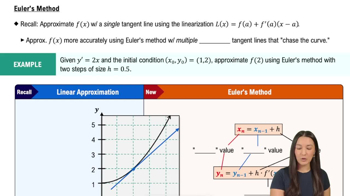Evaluate the integral:
Table of contents
- 0. Functions7h 54m
- Introduction to Functions16m
- Piecewise Functions10m
- Properties of Functions9m
- Common Functions1h 8m
- Transformations5m
- Combining Functions27m
- Exponent rules32m
- Exponential Functions28m
- Logarithmic Functions24m
- Properties of Logarithms36m
- Exponential & Logarithmic Equations35m
- Introduction to Trigonometric Functions38m
- Graphs of Trigonometric Functions44m
- Trigonometric Identities47m
- Inverse Trigonometric Functions48m
- 1. Limits and Continuity2h 2m
- 2. Intro to Derivatives1h 33m
- 3. Techniques of Differentiation3h 18m
- 4. Applications of Derivatives2h 38m
- 5. Graphical Applications of Derivatives6h 2m
- 6. Derivatives of Inverse, Exponential, & Logarithmic Functions2h 37m
- 7. Antiderivatives & Indefinite Integrals1h 26m
- 8. Definite Integrals4h 44m
- 9. Graphical Applications of Integrals2h 27m
- 10. Physics Applications of Integrals 3h 16m
- 11. Integrals of Inverse, Exponential, & Logarithmic Functions2h 34m
- 12. Techniques of Integration7h 41m
- 13. Intro to Differential Equations2h 55m
- 14. Sequences & Series5h 36m
- 15. Power Series2h 19m
- 16. Parametric Equations & Polar Coordinates7h 58m
7. Antiderivatives & Indefinite Integrals
Integrals of Trig Functions
Problem 5.R.54
Textbook Question
Evaluating integrals Evaluate the following integrals.
∫(√1 + tan 2t) sec² 2t dt
 Verified step by step guidance
Verified step by step guidance1
Step 1: Recognize that the integral involves a composite function. The term √(1 + tan(2t)) suggests a substitution might simplify the integral. Let u = 1 + tan(2t).
Step 2: Differentiate u with respect to t. Since u = 1 + tan(2t), we have du/dt = 2 sec²(2t). Therefore, du = 2 sec²(2t) dt.
Step 3: Rewrite the integral in terms of u. Substitute u = 1 + tan(2t) and du = 2 sec²(2t) dt into the integral. This gives (1/2) ∫√u du.
Step 4: Solve the simplified integral. The integral of √u is (2/3)u^(3/2). So, (1/2) ∫√u du becomes (1/3)u^(3/2) + C, where C is the constant of integration.
Step 5: Substitute back u = 1 + tan(2t) to return to the original variable. The final expression is (1/3)(1 + tan(2t))^(3/2) + C.
 Verified video answer for a similar problem:
Verified video answer for a similar problem:This video solution was recommended by our tutors as helpful for the problem above
Video duration:
2mPlay a video:
Was this helpful?
Key Concepts
Here are the essential concepts you must grasp in order to answer the question correctly.
Integration
Integration is a fundamental concept in calculus that involves finding the integral of a function, which represents the area under the curve of that function. It can be thought of as the reverse process of differentiation. There are various techniques for integration, including substitution, integration by parts, and recognizing standard forms. Understanding how to manipulate and evaluate integrals is crucial for solving problems in calculus.
Recommended video:

Integration by Parts for Definite Integrals
Trigonometric Functions
Trigonometric functions, such as sine, cosine, and tangent, are essential in calculus, especially when dealing with integrals involving angles. In this context, the integral provided includes the tangent function and its derivative, sec²(2t). Familiarity with the properties and identities of trigonometric functions is necessary for simplifying and evaluating integrals that involve these functions.
Recommended video:

Introduction to Trigonometric Functions
Substitution Method
The substitution method is a technique used in integration to simplify the process of finding an integral. It involves substituting a part of the integrand with a new variable, which can make the integral easier to evaluate. In the given integral, recognizing that the derivative of the inner function (2t) is present can lead to a successful substitution, allowing for a more straightforward evaluation of the integral.
Recommended video:

Euler's Method

 5:28m
5:28mWatch next
Master Integrals Resulting in Basic Trig Functions with a bite sized video explanation from Patrick
Start learningRelated Videos
Related Practice
